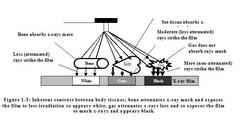Principles of diagnostic radiology
PHYSICAL BASIS OF IONIZING RADIATION
|
PRODUCTION OF X-RAYS
q In the basic x-ray vacuum tube, electrons are boiled off the cathode (filament) by heating it to a very high temperature. To move these electrons toward the anode at energy sufficient to produce x-rays, a high potential difference, up to 125.000 volts (125 KV) is used.
q When the accelerated electrons strike the tungsten anode, x-rays are produced.
q The x-ray tube is completely surrounded by lead on all sides, except for a small exit port. The lead absorbs most of the emitted x-rays except for the portion that escapes through port.
Radiologic density
There are two types of density encountered in X-rays recording media:
1. Physical density: a density of material is the number of grams per cubic centimeter. The greater the physical density, the greater the ability of material to absorb and scatter x-rays (greater attenuation).
2. Radiographic density: radiographic density refers to the degree of blackness of a film. The radiographic density of a substance is related to its physical density. The effect on film or other recording media occurs “paradoxically”; structures of high physical density produce less radiodensity (less blackening or more whitening) and vice versa.
q Structures that produce more blackening on film are referred to as being radiolucent, the one that produce less blackening is called radiopaque or radiodense.
q Generally, structures are of four types of radiographic densities; these are, in increasing order of physical density:
Ø Gas (air): appears black due to its low density that does not attenuate the x-rays.
Ø Fat appears gray black
Ø Water (soft tissues) appears gray
Ø Bone: appears white due to its high density and the great attenuation of x-rays as they pass through it.
RECORDING MEDIA
q This is the most familiar recording media.
q X-ray film consists of a plastic sheet coated with a thin emulsion of silver bromide and a small amount of silver iodide. This emulsion is sensitive to light and radiation.
q When film is exposed to ionizing radiation then developed, chemical changes take place within the emulsion resulting in the deposition of metallic silver, which is black.
q The amount of blackening on the film depends entirely on the amount of radiation reaching the film and, therefore on the amount of attenuated or removed x-rays from the beam by tissues.


